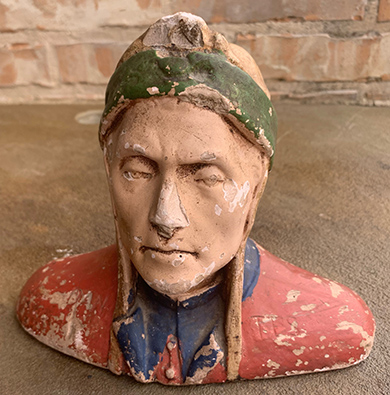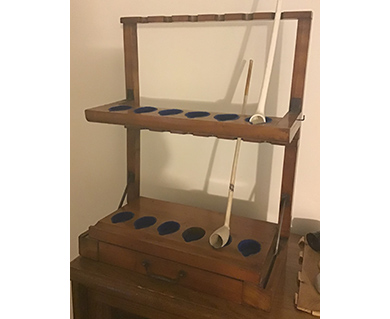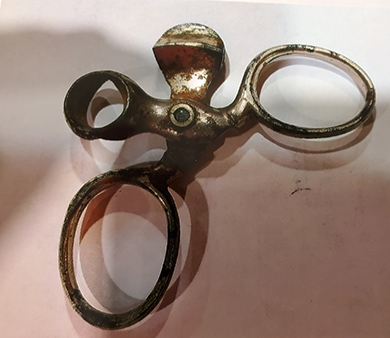 |
|
|||
 |
 |
|||
RINKER ON COLLECTIBLES — Column #1771 Copyright © Harry Rinker, LLC 2020 Questions
and Answers
QUESTION: I inherited a chalk art piece that is an unusual native American bust. I love the patina and the years of wear as well as the family history connected to it. Although I am certain it is a carnival art piece, I was told that it was a 1920s purchase from a now defunct Midwest store. I have looked everywhere on the internet and none of the examples I have seen are the quality of this piece. Can you direct me to any sources where I can determine the history and origin of the piece and its value? I can send photographs if that helps. – LJ, Fort Worth, TX, Email Question 
ANSWER: I can do better than that. I can answer all your questions for you. The bust dates from the 1910s or 1920s. It is definitely not carnival chalkware. When I first received your email, my thoughts immediately turned to the elaborate painted chalkware cigar store Indian busts of warriors and maidens that were produced at the end of the 19th and early 20th century. I have seen several of these during my antiques and collectibles travels and confess I had to use all my will power not to acquire one for my collections. I have learned when pictures do not accompany a question that often what I envision in my mind is far different from the appearance of the object owned by the person submitting the question. As a result, I decided to ask JL to send me .jpg photographs of the bust. Thanks, JL for responding positively to my request. When I inspected the pictures, I noticed “TES” on the left shoulder of the bust. The old phrase “haste makes waste” applied, a situation that resulted in a “dumb me” moment ten minutes later. I immediately did a “chalkware Indian bust” search on WorthPoint.com. After examining more than 700 images, several of which resulted in a “nostalgic moment” when I encountered a cigar store Indian bust, I found nothing closely resembling your “Native American” head. I returned to the images and took another look. A light bulb moment suggested that the bust was not that of a Native American but rather an Italian Renaissance figure. It took several additional searches but eventually I identified the subject of the bust – Dante. It is time for the “dumb me” moment. If there is a “TES” on the right shoulder, there should be a “DAN” on the right. Although not evident at first glance when looking at the photograph on the bust, closer examination reveals its presence. A WorthPoint.com search of “Chalkware Bust Dantes” turned up listings for several identical examples. Your photographs were helpful in a second way. They revealed the condition of your Dantes statue. It is in poor condition. Large sections of the period paint are missing. It is scratched in some sections. Its appeal is its sentimental value to you. It has no resale value because of its condition. Although examples do not appear regularly on internet sale sites such as Ebay, they appear often enough that any buyer with patience who wishes to add one of these Dantes chalkware busts in very good or better condition to his/her collection can do so for less than $50.00. QUESTION: I believe I own a “colonial times” pipe rack used to peddle clay pipes. When collapsed it looks like a toolbox, that is to say it folds up into first tier and then a second tier as an antique high-chair did. What can you tell me about it? – JA, Denver, PA, Letter 
ANSWER: First, it does not date from the colonial period 1725 to 1800. It most likely dates from the early 20th century, albeit it is not clear if it is a commercial or handmade example. Apply the first of my authentication rules: if it looks new, assume it is new. In this instance, new may be 75 to 100 years old. If it has not been refinished, think a later date of origin. The pipe rack shows none of the age and wear signs one would expect in an object over 200 years old. Further, the mechanical mechanism that allows the pipe rack to fold is late 19th century or early 20th century in origin at the earliest. 18th century clay pipe reproductions are readily available from multiple sources such as Old Dominion Clay Pipes. You will find reproduction (exact copies) or copycat examples of similar clay pipe racks in some restored 18th century taverns such as those in Colonial Williamsburg. If your folding pipe racks dates from the late 19th or early 20th century, its value is around $100.00. If it is a 1920s or later Colonial Revival piece, the value diminishes to between $20.00 and $25.00. QUESTION: I have a metal scissors-like device. One arm ends in a round tube circle. The other with a small blade like cutter that closes over the tube to nip something. It measures 2 1/4-inches by 1 1/2-inches. I could find no markings on it. What do I have? -- AJ , Greenwood, IN, Email Question 
ANSWER: You have a scissors-type cigar cutter that was used to open up the head of the cigar to allow it to draw. The first cigar cutters date from the late 1860s. Within a decade, the cigar cutter evolved into a knife-like device. By 1900, most male cigar smokers owned one or more cigar cutters. Many attached them to the end of a watch chain or kept them in a trouser or vest pocket. Your cigar cutter closely resembles a cigar cutter made by GCW of Germany at the end of the 19th or early 20th century. Your cigar cutter needs a good cleaning. Because it is unmarked, its secondary market, retail value is between $25.00 and $35.00. QUESTION: I want to sell some of the stamps in my collection. I have mostly blocks of four United States stamps from the 1960s and 1970s. I could group them and look them up in the Scott references. However, I recognize these are lower value stamps. Is eBay a good source? Are there other selling choices? – TM, Email Question ANSWER: Do not waste your time looking up your stamps in the Scott catalogs. First, the values are retail and not wholesale. Second, the Scott prices, especially for recent issues, are what dealers ask but not what they get. Plate blocks are a glut on the market. The Golden Age of Plate Block Stamp Collecting is in the far distant past. The 1960s and 1970s marked the end of the era. Most plate blocks sell for a dollar or less. Any money above the face value of the stamps in the plate block is a bonus. There are a few plate blocks that appeal to crossover collectors, for example, the American Revolutionary War commemorative stamps from 1976, albeit most crossover collectors who want an example already own one. Do not attempt to sell the plate blocks individually. Rather group them in lots of 15 to 25. The good news is that the cost to ship them to a successful buyer is minimal. When I encounter 1960s sheets (panes) and blocks of stamps, my suggestion to clients is to use them. The face value of unused stamps never goes away. My own rule when I buy these stamps is to never pay more than 70 percent of the face value of the stamps. This is lower than the more traditional 85 to 80 percent of face value dealers charge, but as my readers are aware, I am a cheap buyer. Let me know how you handled the sale and what success you had. Good luck. Harry L. Rinker welcomes questions from readers about
collectibles, those mass-produced items from the twentieth and twenty-first centuries.
Selected letters will be answered in this column.
Harry cannot provide personal answers.
Photos and other material submitted cannot be
returned.
Send your questions to: Rinker on Collectibles, 5955 Mill
Point Court SE, Kentwood, MI 49512.
You also can e-mail your questions to
harrylrinker@aol.com.
Only e-mails containing a full name and mailing address
will be considered.
|
||||